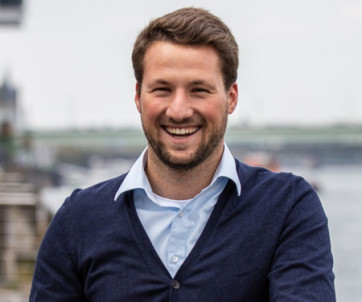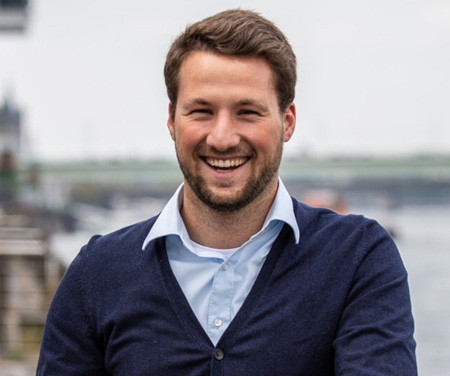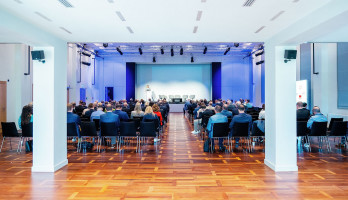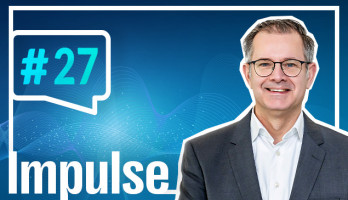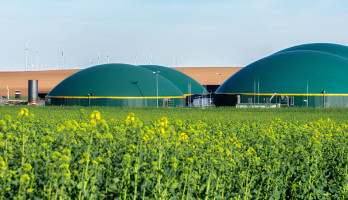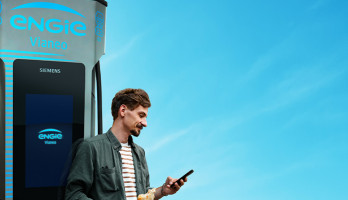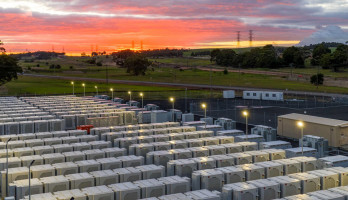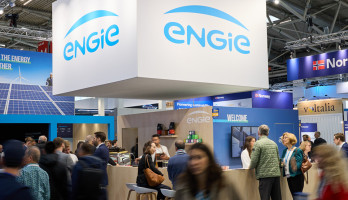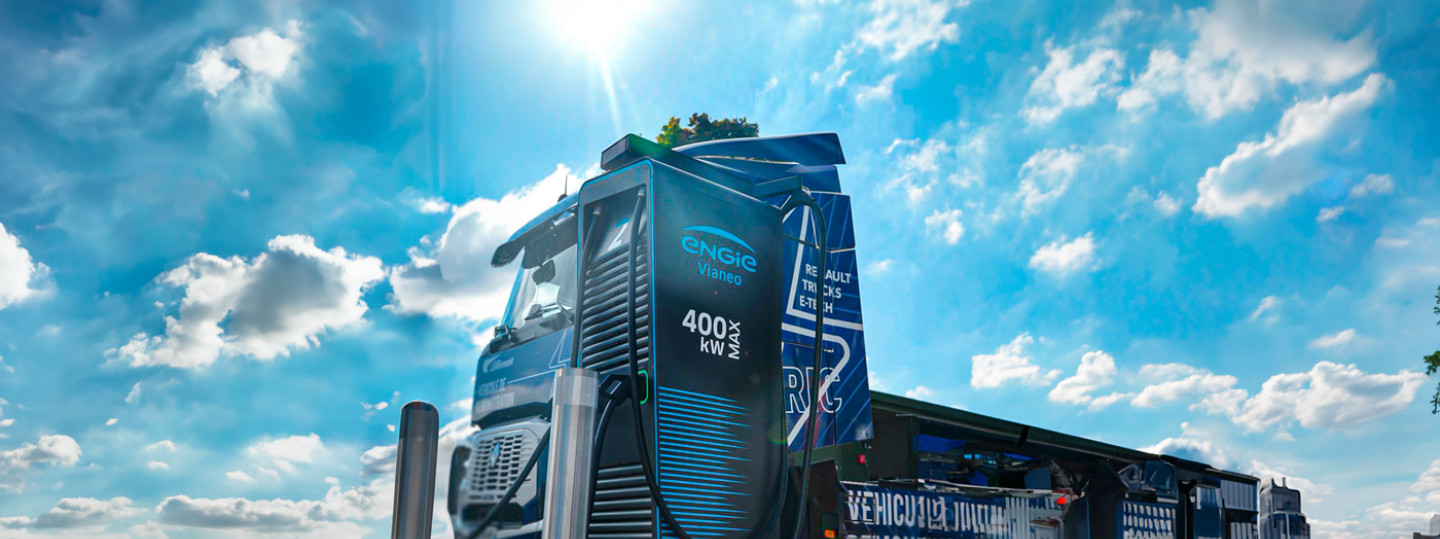
Power for heavyweights – How ENGIE Vianeo is driving forward electric mobility for trucks
The electrification of heavy-duty transport is gaining momentum. With it comes an increasing demand for powerful, intelligent e-charging infrastructure for trucks. With ENGIE Vianeo, a brand of the ENGIE Group, we are positioning ourselves as a strategic driver of electric mobility for commercial vehicles in Europe. Following a successful market entry in France, we are now entering the German market alongside Spain and Belgium.
ENGIE Vianeo: Energy expertise meets logistics reality
Vianeo already operates almost 10,000 charging points across Europe, around 800 of which are located on motorways. By 2030, this figure is set to rise to 25,000 charging points, in addition to 1,500 specifically for commercial vehicles.
The goal: a reliable charging infrastructure powered entirely by green electricity that will drive the European mobility transition. After all, electric mobility is the better solution, both economically and ecologically. The focus is on digitalization, high charging power, and reservability for a consistent user-centric experience.
France as a real-world laboratory: successful projects that serve as role models
In France, ENGIE Vianeo has already demonstrated what a high-performance e-charging infrastructure for trucks can look like:
- Lyon-Paris corridor: 5 fast charging locations with up to 480 kW charging capacity, approx. 300 km range in 45 minutes (every 150 km along the route)
- ECTN corridor (Sommesous): Use of the relay principle (driver change at the moment of the legally prescribed rest break) with the result: up to 60% reduction in emissions
- Multi-energy stations (e.g., Dardilly, La Galande): Combination of electricity, biogas, and PV, providing flexible energy supply directly on site
These projects serve as blueprints for scaling truck electromobility in other European markets.
Thinking economically about electric truck mobility – with energy expertise and a focus on logistics
How can economically viable charging tariffs be designed? When will the first e-charging stations be available in Germany? And how does a company like ENGIE Vianeo measure the success of electric truck mobility?
ENGIE's energy expertise is a major differentiator in the market. What does that mean specifically, and what do you hope to achieve with it?
Jan-Niklas Ellerich: On the one hand, the energy market is very complex and highly regulated. This means that it is crucial to be familiar with the entire regulatory framework, as well as the various interfaces and stakeholders involved. These include distribution system operators, balancing groups, and compliance with calibration regulations. So there is much more to this topic than meets the eye.
It gets particularly exciting when it comes to pricing, i.e., the question of how to offer the most favorable price possible. This is because the logistics industry is very price-sensitive.
This is where innovative tariff models come into play, such as a dynamic charging tariff. In concrete terms, this means that electricity is traded on the exchange and we pass on the exchange prices directly to our customers without engaging in expensive hedging.
In Germany, we have a high proportion of renewable energies. These are extremely cheap for electricity generation, but also volatile. As a result, electricity prices fluctuate greatly throughout the day, from very cheap to very expensive. We want to make targeted use of these fluctuations, especially for the logistics industry.
This is because we have observed that electricity is almost always very cheap or very expensive at the same times of day. Thanks to the high proportion of renewable energies, there are even times when prices are negative. This means that you get paid to use electricity. Although taxes, levies, and charges still have to be paid, it remains very cheap.
These cheap hours are ideal for logistics companies to take advantage of. And in certain cases, the whole thing can be optimized with storage: you charge the storage unit during the cheap hours and use the electricity later to charge commercial vehicles. This allows you to buy electricity when it is cheap and then use it when you need it.
There are many different models and ways to take advantage of these price benefits. Our goal is to enable our customers to do just that through dynamic electricity and charging rates. This requires a deep understanding of the energy market. At ENGIE, we have this expertise, and we see it as one of our key competitive advantages.
What is your time frame? When will the first locations for electric trucks go into operation in Germany?
Jan-Niklas Ellerich: The project pipeline is well filled. We have already signed the first projects and are in the process of developing further ones. Once an agreement has been reached with the respective landowners, we expect construction to take around nine to twelve months per location.
Currently, European funding plays an important role, as it influences when the charging points can go into operation. Specifically, this is the Alternative Fuels Infrastructure Facility (AFIF), a European Union funding program to support the expansion of infrastructure for alternative fuels such as electric mobility. The funding conditions under the AFIF can have a temporal impact on commissioning, as certain administrative and technical requirements must be met before funds are released. We therefore expect the first charging points to open in late summer 2026.
Theoretically, we could start earlier at individual locations, but we have to coordinate this carefully with regard to the funding requirements. The goal is to operate in a way that is both economically sensible and compliant with the funding requirements.
Looking back in five years, what needs to have happened for you to say that we have been successful?
I would like to divide this into three levels: socially, from an industry perspective, and for us as a company.
From a societal perspective, I would like to see recognition of the fact that, for purely physical reasons, mobility cannot be organized more cheaply than electrically in the long term. The energy efficiency of electric mobility is around 90% when viewed from a well-to-wheel perspective, around 50% for hydrogen, and even lower for diesel. These facts cannot be argued away; they are a physical given. If the technological requirements are at a comparable level, there is simply no rational reason to deviate from electric mobility, unless you want to pay extra.
In addition, electricity—unlike hydrogen or diesel—is much easier to transport. Even if storage is more difficult, power connections can be organized much more quickly and flexibly than large hydrogen or diesel tanks. My wish would therefore be for us as a society to recognize that electric mobility is not our enemy, but our greatest ally.
For the industry, I hope that this insight will lead to a real market ramp-up, both for passenger cars and trucks. This is already happening in China, where electric mobility has long been a reality and has arrived on the mass market. I find it difficult to understand why we in Europe continue to artificially cling to "technological openness." This made sense at the beginning, but now we need to use resources as efficiently as possible and scale up.
For ENGIE as a company, we see success when we achieve a significant market share in this developing market. So if society recognizes the physical facts, the industry grows dynamically as a result – and we play a leading role in this – then we will have achieved a great deal.
And personally, I would add: if we manage to combine the advantages of renewable energies with electromobility, then enormous potential will be unleashed. Because volatile, cheap green electricity is a perfect match for electromobility. Vehicles are basically rolling storage units. This combination of fluctuating power generation and flexible storage use is ideal. If we use this systematically, we can organize mobility at a cost that we can hardly imagine today. And with the current pace of innovation, this is entirely achievable within the next five years.
Conclusion: Truck electromobility requires swift action and smart solutions
The electrification of heavy-duty transport is one of the key challenges of the mobility transition. ENGIE Vianeo shows how charging infrastructure for trucks can be not only technically feasible, but also economically viable and sustainable. By focusing on energy expertise, digital solutions, and close cooperation with the logistics industry, we are laying the foundation for the rapid scaling of electric mobility in the commercial vehicle segment in Europe.
The successful projects in France serve as models for rapid implementation in Germany and beyond. But the road to success requires more than innovative technologies: it requires political determination, a clear market ramp-up, and the promotion of intelligent tariff models that meet the requirements of the logistics industry.
If all stakeholders pull together—from industry and politics to consumers—electric mobility can pave the way for a sustainable and cost-efficient transport transition in the coming years.
Our Expert
